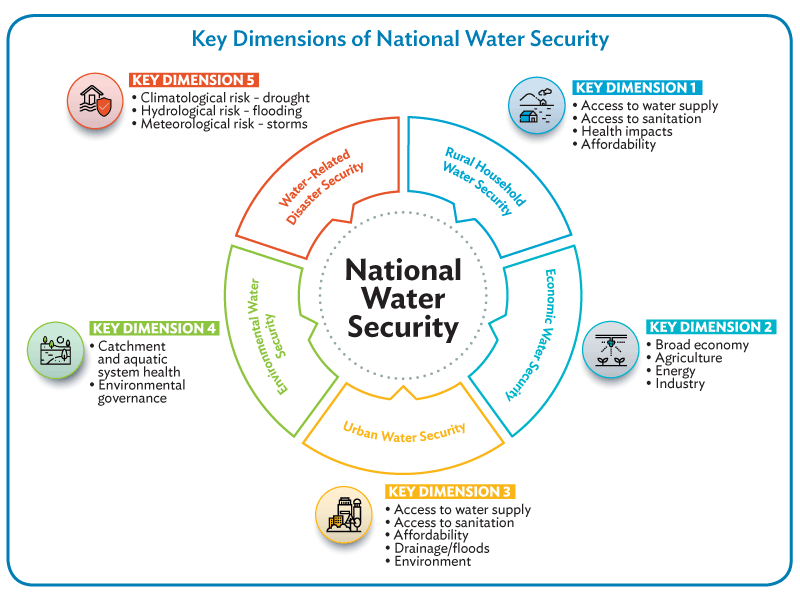Asian Water Development Outlook (AWDO): Advancing Water Security across Asia and the Pacific
ADB’s Vision on Water Security and AWDO 2020
AWDO provides an up-to-date overview of the region’s water security, showing progress and enabling methodological comparison over time. It aims to inform decision-making and public–private investments toward achieving water security in the region. There is both a physical text and a data dashboard, which allows the user to visualize water security in a more granular fashion according to user requirements.
To quantify water security in Asia and Pacific, ADB developed a framework with five interdependent key dimensions (KDs, see illustration). The vision for water security is built on five concepts: societies can enjoy water security when they successfully manage their water resources and services to (i) satisfy rural household water and sanitation needs in all communities; (ii) support productive economies in agriculture, industry, and energy; (iii) develop vibrant, livable cities and towns; (iv) restore healthy rivers and ecosystems; and (v) build resilient communities that can cope with water-related extreme events.
Water security therefore depends on the availability of an adequate quantity and quality of water to ensure safe, affordable, equitable, and inclusive water supply and sanitation, together with sustainable livelihoods and healthy ecosystems and manageable water-related risks.

Each country’s overall national water security (NWS) is assessed as the composite result of the five KDs (KD1–KD5). AWDO measures water security by quantifying the five KDs in terms of clear and measurable indicators The five KDs of water security are related, interdependent, and should not be treated in isolation. Measuring water security by aggregating indicators in these KDs recognizes their independencies. Increasing water security in one dimension may simultaneously increase or decrease security in another dimension and affect overall NWS. Given the interdependence of the factors determining water security in each dimension, increases in water security will be achieved by governments that break the traditional sector silos to find ways of managing the linkages, synergies, and trade-offs among the dimensions with holistic and integrated approaches.
| Index | Measurement | Composition |
| National Water Security Index | The availability of adequate water to ensure safe and affordable water supply, inclusive sanitation for all, people’s livelihoods and healthy ecosystems, with reduced water-related risks toward supporting sustainable resilient rural-urban economies | Total of the five dimensions of water security |
| KD1: Rural household water security | The provision of sufficient, safe, physically accessible, and affordable water and sanitation services for health and livelihoods, coupled with an acceptable level of water-related risk, in rural households | Access to water supply; Access to sanitation; Health impacts; Affordability |
| KD2: Economic water security | The assurance of adequate water to sustainably satisfy a country’s economic growth and avoid economic losses due to water-induced disasters | Broad economy; Agriculture; Energy; Industry |
| KD3: Urban water security | The extent Asian Development Bank members provide safely managed and affordable water and sanitation services for their urban communities to sustainably achieve desired outcomes | Access to water supply; Access to sanitation; Affordability; Drainage (flooding); Environment (water quality) |
| KD4: Environmental water security | The health of rivers, wetlands, and groundwater systems and measured progress on restoring aquatic ecosystems to health on a national and regional scale | Catchment and Aquatic System Condition Index; Environmental Governance Index |
| KD5: Water-related disaster security | A nation’s recent exposure to water-related disasters, their vulnerability to those disasters, and their capacity to resist and bounce back | Climate risk (drought); Hydrological risk (flood); Meteorological risk (storm) |
The five KDs form the National Water Security Index (NWSI). The maximum score for each KD is 20. The maximum NWS score—the sum of the KDs—is 100. At NWSI Stage 1, the water situation is nascent, and there is a large gap between the current state and the acceptable level of water security. At NWSI Stage 5, the country may be considered a model for its management of water services and resources, and as water secure as possible under current circumstances.
| NWS Stage (Index) | NWS score | Description |
| Model (5) | 96 and above | All people have access to safe, affordable, and reliable drinking water and sanitation facilities. Economic activities are not constrained by water availability. Environmental governance is good, and pressure on aquatic ecosystems is limited. Water-related risks are acceptable and relatively easy to deal with. |
| Effective (4) | 78–96 | Nearly all people have access to affordable safe drinking water and sanitation facilities. Economic water security is high. Environmental governance is generally acceptable, and attention is given to ecological restoration. There are systematic commitments to reduce disaster risk. |
| Capable (3) | 60–78 | Access to safe drinking water and sanitation facilities is improving. Economic water security is moderate. Environmental governance is moderate, with clear pressure on the ecosystem. There are some institutional commitments to reduce disaster risk. |
| Engaged (2) | 42–60 | A significant majority of rural and urban households have access to basic water supply but less to sanitation. Economic water security is low. Environmental governance is moderate, with severe pressures on aquatic ecosystems. Progress in achieving disaster risk security is low. |
| Nascent (1) | 0–42 | A low proportion of rural and urban households have access to basic water supply and sanitation. Economic water security is low. Environmental governance is poor, with significant pressures on the aquatic ecosystems. Hardly any attention is given to disaster risk reduction. |


